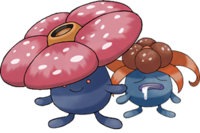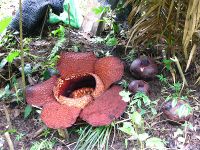On the Origin of Species: Gloom and Vileplume
|
|
Last time, I discussed Oddish, and its basis in the myths surrounding the mandrake. Today we'll be looking at two of Oddish's evolutions, Gloom and Vileplume, both of which were inspired by an even stranger plant, Rafflesia arnoldii. Its claim to fame is having the largest flower of any plant in the world, but this isn't the only thing that makes it unusual.
The Rafflesia genus is found in a few rain forests across Southeast Asia, and breaks many of the rules we associate with flowering plants. To begin with, its members have no leaves, stems or visible roots. The only visible feature that they have in common with other flowering plants is the flower itself... and even that is only in bloom for brief periods of time. For the rest of the time, the only evidence of the plant's existence is a closed-up, dark-colored bud.
Another atypical feature of Rafflesia is that they can't photosynthesize. Photosynthesis is the process used by almost all plants to make food for themselves: they take in sunlight and use it to make sugar out of carbon dioxide and water. Rafflesia contain no chlorophyll, the green pigment used to absorb sunlight, and so photosynthesis is impossible for them. They use a very different strategy for obtaining food, one that's very uncommon for plants. Rafflesia are parasites. Their roots have evolved into appendages called haustoria, which burrow into the tissue of other plants and suck out nutrients. Rafflesia are picky eaters, too: they feed exclusively on Tetrastigma, a type of vine from the grape family.
The distinctive five-petaled flowers are visible for just a few days, but they take many months to develop as buds. On the rare occasions that they are visible, though, they're striking and instantly recognizable. The size varies depending on the species of Rafflesia, though in all cases they are large. Rafflesia arnoldii's are the largest, growing to over a meter in diameter and weighing over eleven kilograms, thus making them the largest flowers in the world.
In addition, the flowers give off an extremely pungent smell similar to rotten meat. They seem to resemble rotting flesh visually, too. Given that we're used to flowers that smell pleasant, or at the very least inoffensive, this seems very odd. But if we look more closely, we can see that a sweet-smelling flower and a pungent-smelling flower are actually two ways of achieving the same objective: pollination. A regular flower attracts insects with its sweet scent. The insects get covered in the flower's pollen, which they then spread to other flowers of the same species, resulting in pollination. Insects are drawn to sweet scents because it usually means that there's food for them. And many insects are also drawn to rotting meat, for exactly the same reason. Flies and other insects are attracted to Rafflesia flowers by the scent of what appears to be a free meal, and then end up spreading the plant's pollen to others of its kind. Though they couldn't be more different to our delicate noses, these are actually two examples of the same reproductive strategy.
Indeed, Rafflesia isn't the only group of plants to mimic the smell of rotting flesh, although it probably puts more effort into the illusion than others do. It's not surprising, then, that they're commonly known as 'corpse flowers'. While they remain relatively obscure in the West, Japan seems to have developed a fondness for Rafflesia, and they can often be glimpsed in various anime series and video games. The fact that they inspired two first-generation Pokémon could also be taken as proof of their cultural significance.
As far as their resemblance to their real-life counterparts go, Gloom and Vileplume's Pokédex entries mostly focus on the smell that they produce, and the fact that Vileplume's flower is the biggest in the world. Visually, Vileplume's design is closer to the flowering Rafflesia arnoldii, while Gloom's smaller flower and round body suggests that it is based on a bud in the process of flowering. Both Pokémon's bodies have the dark purple color of Rafflesia bulbs, and contain no green pigments.
As iconic as Rafflesia is, the various species are all under threat, due mostly to their highly specialized lifestyle which makes them vulnerable to any changes in the environment. They're completely dependent on Tetrastigma vines for nutrition, and these vines are mostly limited to undisturbed rain forests, so any human encroachment into such environments puts Rafflesia at risk. In addition, reproduction is a very hit-and-miss affair for these plants: their flowers bloom for only a few days, and flowers are also unisexual (meaning that they can be either male or female, but not both). All of this means that the chances of one flower successfully pollinating another are quite low. This kind of reproductive cycle would make it very difficult for Rafflesia to quickly recover from a drop in population, and so some conservationists are looking at ways to enable these plants to grow outside of their natural environment. And who among us can honestly say that they wouldn't want a corpse flower in their garden?
Hmm... Maybe it's just me, then.

